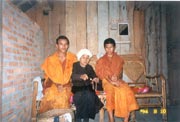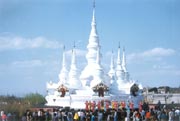| Stupa, Temple and Young Buddhist Monks
The Dai people believe in Hinayana (Little Vehicle, a branch of Buddhism), which is, with the formal name of "Nanchuan Shangzuo Sect of Buddhism", a sect of Buddhism. It was introduced into Dai areas of China through Burma and Thailand, more than a thousand years ago. Hinayana is a demoting name for the early Buddhism after Mahayana appeared. Hinayana asserts to donate "Dan", to accumulate one's good deeds for the next life, and to achieve self-salvation and self-extrication. However, believers of Mahayana consider they are able to save all the others, so they call the opposite sect as Hinayana, which means small dolly. Afterwards, in order to distinguish it from Mahayana sect, Nanchuan Shangzuo sect was habitually called Hinayana, which became the name of the sect, with no demotion any more.
 It is said that the early believers of Hinayana had once attended to Sakyamuni's preaching. They think that if people do not cultivate themselves by accumulating good deeds in this life, they would go to hell to suffer a lot after death - "Do good to others. The more good deeds, the more virtues, and then I can be immortal." Hinayana is almost the religion of the whole Dai group. There are temples in every village. Every Dai do go to worship Buddha. Hinayana advocates entering the temple as a monk and getting cultivated religiously. Therefore the Dai boys used to live in the temple for a period of time separated from the family. In their eyes, only men who had been a monk were men of knowledge and cultivation, and could be respected in society. Men who have not been a monk are called "Yanbai" and "Yanling", referring to those having no knowledge and no cultivation. Monks of Hinayana are divided into different levels, which determine their positions in the temple. Newcomers are called Heshang, which is further divided into Payi (senior Heshang) and Panan (junior Heshang). They are trained before entering temple, and allowed in after they have generally been familiar with regulations of the temple. On that day, the boy should be dressed in colorful clothes and hat by his recognized godfather, who is faithful to Buddha, erudite and respectable, and then rides, either on a horse or on a person, to the temple, accompanied by his relatives and neighbors. All the watchers on the street would sprinkle parched rice over him. Entered the great hall, the boy kneels down to receive the initiation ceremony held by the temple. His nominal father then takes off the colorful clothes and hat for him, and put on cassock. Now the boy is a true junior monk. From this moment on, he will live in the temple, study the Dai language and sutra with Foye, a higher-level monk, as well as go to beg alms and do part of odd jobs in the temple. When he grows up, he can be promoted as Panong, Du ( Foye, both junior and senior), Huba, etc. Generally speaking, monks above Huba cannot get secularized. So many people are not willing to become Huba, and they usually get secularized to establish their careers and families after a senior Foye. It is said that the early believers of Hinayana had once attended to Sakyamuni's preaching. They think that if people do not cultivate themselves by accumulating good deeds in this life, they would go to hell to suffer a lot after death - "Do good to others. The more good deeds, the more virtues, and then I can be immortal." Hinayana is almost the religion of the whole Dai group. There are temples in every village. Every Dai do go to worship Buddha. Hinayana advocates entering the temple as a monk and getting cultivated religiously. Therefore the Dai boys used to live in the temple for a period of time separated from the family. In their eyes, only men who had been a monk were men of knowledge and cultivation, and could be respected in society. Men who have not been a monk are called "Yanbai" and "Yanling", referring to those having no knowledge and no cultivation. Monks of Hinayana are divided into different levels, which determine their positions in the temple. Newcomers are called Heshang, which is further divided into Payi (senior Heshang) and Panan (junior Heshang). They are trained before entering temple, and allowed in after they have generally been familiar with regulations of the temple. On that day, the boy should be dressed in colorful clothes and hat by his recognized godfather, who is faithful to Buddha, erudite and respectable, and then rides, either on a horse or on a person, to the temple, accompanied by his relatives and neighbors. All the watchers on the street would sprinkle parched rice over him. Entered the great hall, the boy kneels down to receive the initiation ceremony held by the temple. His nominal father then takes off the colorful clothes and hat for him, and put on cassock. Now the boy is a true junior monk. From this moment on, he will live in the temple, study the Dai language and sutra with Foye, a higher-level monk, as well as go to beg alms and do part of odd jobs in the temple. When he grows up, he can be promoted as Panong, Du ( Foye, both junior and senior), Huba, etc. Generally speaking, monks above Huba cannot get secularized. So many people are not willing to become Huba, and they usually get secularized to establish their careers and families after a senior Foye.
 It is said that a stupa (A Buddhist Tower) was constructed earlier than Buddhist temple in Dai areas. Although it has a longer history than temples, there are more temples than stupas. A Buddhist temple is the place where all the followers are cultivated. All the Dai people believe in Buddhism, so there are temples in every village. A Stupa is used to contain the teeth, bone and hair of Buddha, which are so-called Sheli. So stupas are all exquisitely built. There is a stupa named Manfeilong Bamboo Shoot Stupa, located on the back hill of Damenglong Mengfeilong village in Jinghong County, Xishuangbanna. It is said that the stupa was built because of a footmark of Sakyamuni there. The structure is novel and beautiful, and of Dai constructional characteristics. It looks like a bamboo shoot after a rain, thus it is called the Bamboo Shoot Stupa. It was built in 565 by Dai calendar (1204 A.D.). The main stupa is 16.29 metres high, with 8 smaller ones around, each 5.02 metres high. All the nine stupas are like a calabash, snow white on the main body, with weather vanes and bronze bells decorating the top, ringing pleasantly in the wind. At the foot of every stupa there is a square niche, with a stone sculpture in it. Beneath the niche of the south stupa, there is a huge footmark on the rock, in front of which there is a well. It is said both are "holy marks" left by Buddha. This stupa is well-known as a treasure of ancient Dai construction and a giant among XishuangBanna stupas. It is said that a stupa (A Buddhist Tower) was constructed earlier than Buddhist temple in Dai areas. Although it has a longer history than temples, there are more temples than stupas. A Buddhist temple is the place where all the followers are cultivated. All the Dai people believe in Buddhism, so there are temples in every village. A Stupa is used to contain the teeth, bone and hair of Buddha, which are so-called Sheli. So stupas are all exquisitely built. There is a stupa named Manfeilong Bamboo Shoot Stupa, located on the back hill of Damenglong Mengfeilong village in Jinghong County, Xishuangbanna. It is said that the stupa was built because of a footmark of Sakyamuni there. The structure is novel and beautiful, and of Dai constructional characteristics. It looks like a bamboo shoot after a rain, thus it is called the Bamboo Shoot Stupa. It was built in 565 by Dai calendar (1204 A.D.). The main stupa is 16.29 metres high, with 8 smaller ones around, each 5.02 metres high. All the nine stupas are like a calabash, snow white on the main body, with weather vanes and bronze bells decorating the top, ringing pleasantly in the wind. At the foot of every stupa there is a square niche, with a stone sculpture in it. Beneath the niche of the south stupa, there is a huge footmark on the rock, in front of which there is a well. It is said both are "holy marks" left by Buddha. This stupa is well-known as a treasure of ancient Dai construction and a giant among XishuangBanna stupas.
Carpet-Wrapping Courting and Threading-Tying Marriage <<
>>
|